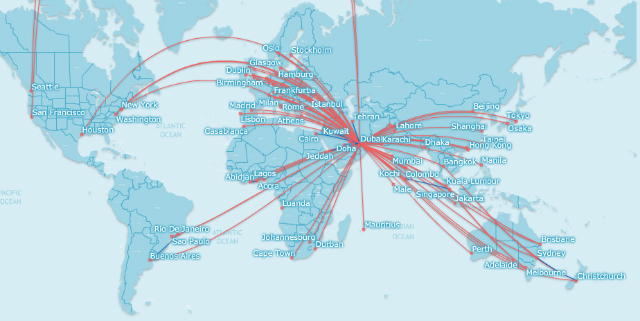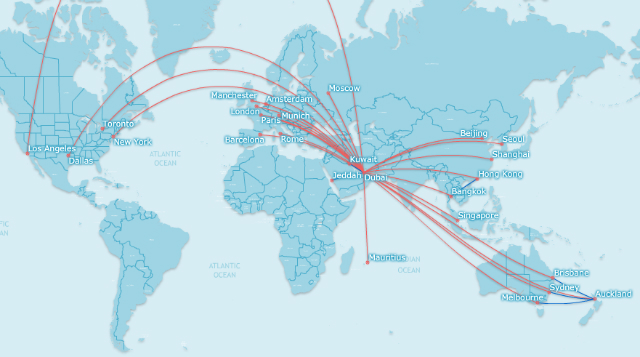Emirates Airline's decision to cancel orders for 70 Airbus A350s has opened up the possibility that its future fleet could only have two types – the Boeing 777 and A380.
While the airline president Tim Clark has expressed frustration at the changes to the design of the 20 A350-1000s it had on order, the cancellation of its order for 50 -900s effectively leaves it without a replacement for aircraft in the 230-260 seat category. These include a number of A330s, A340s and 777-200/200ERs, which are the oldest aircraft in its fleet - with the exception of the A340-500s, which are being phased out due to their poor economics.

Those smaller widebodies mostly operate on services to Africa, the Middle East and Indian subcontinent, but are increasingly overlapping with the larger 777-300ERs. FlightMaps Analytics shows that the large Boeing operates 49% of the airline's frequencies on a range of routes: from longhauls down to Australia and the US, to even the 45 minute flight between Dubai and Doha.
Emirates 777-300ER routes

Emirates A330/A340/777-200/777-200ER routes

Flightmaps Analytics
The larger 777s are also being supplemented by the A380s, especially on longer routes. Flightglobal understands that across Emirates’ network the A380 and 777-300ER offer broadly similar seat-mile costs, however the latter carries considerably more cargo on some routes.
Emirates A380 routes

FlightMaps Analytics
This allows the airline to tailor its schedule so that those frequencies with a high passenger load are operated by the A380, while off-peak passenger times can allow it to carry more cargo with the 777s. Similarly, it allows for efficient upgauging at slot-constrained airports, such as London Heathrow, and even at its home base at Dubai International airport.
With the A350s off the table – at least for now – the only type that is expected to be added over the next decade is the 777-9X. Clark says that the airline is close to firming a commitment placed at the Dubai air show for 150 firm aircraft and 50 options, and an announcement could be forthcoming at the Farnborough air show.
The 777-9Xs are the natural replacement the 777-300ERs, albeit over some time given the scale of the -300ER fleet. As well as a slightly larger capacity, the efficiency benefits offered by the -9X will fit well with Emirates’ focus on delivering low seat-mile costs.
It is for that reason that Clark has been pressing Airbus to look at re-engining the A380 later in the decade. Once the 777-9X’s enter service, their per-seat costs are expected to beat the A380’s, which changes the cost dynamics for Emirates. Re-engining the megaliner would allow it to maintain the status quo.
All of that appears to show that Emirates may be looking only to the 777X and A380 for its future fleet. Given that the A350 cancellation came in response to a reassessment of its future fleet needs, there may be an indication that it does not see itself operating aircraft with less than 350 seats in the near future.
As FlightMaps shows, the smaller widebodies already only have a few routes of their own. As it has done elsewhere, Emirates could move to upgrade those to 777-300ERs and later 777-9Xs or A380s as the market grows. Although adding those larger aircraft to such routes would drive down yields in the short-term, the airline has shown that it is happy to wear that – often to the detriment of its competitors. It could also look to consolidate frequencies on some routes, or indeed drop them altogether.
Down the track, though, Emirates could re-look at its options to replace the A330s, A340s and early 777s if it decides that smaller aircraft are required. That could see the 787 – particularly the 787-10 – come into the frame, with the benefit of cockpit commonality with the 777s. Airbus would be expected to also put forward compelling offers for the A350, and maybe even the A330neo if it is launched.
The other option could be for Emirates to deepen its relationship with low-cost carrier FlyDubai. The smaller carrier is not part of the Emirates group, and there are few overlaps between them. However they now offer interline connections on certain routes, as does Emirates' alliance partner Qantas.
FlyDubai is solely a 737 operator, and has also signed on for the Max in both the -8 and -9 variants, giving it much less capacity than its larger stablemate. However, it is possible that the fleet could be expanded to include smaller widebodies, something that would probably be essential if it were to play a larger feeder role to Emirates.
Given the scale of Emirates’ 777/A380 network now, it seems a logical development that the airline will focus solely on those types going forward.
Source: Cirium Dashboard



















